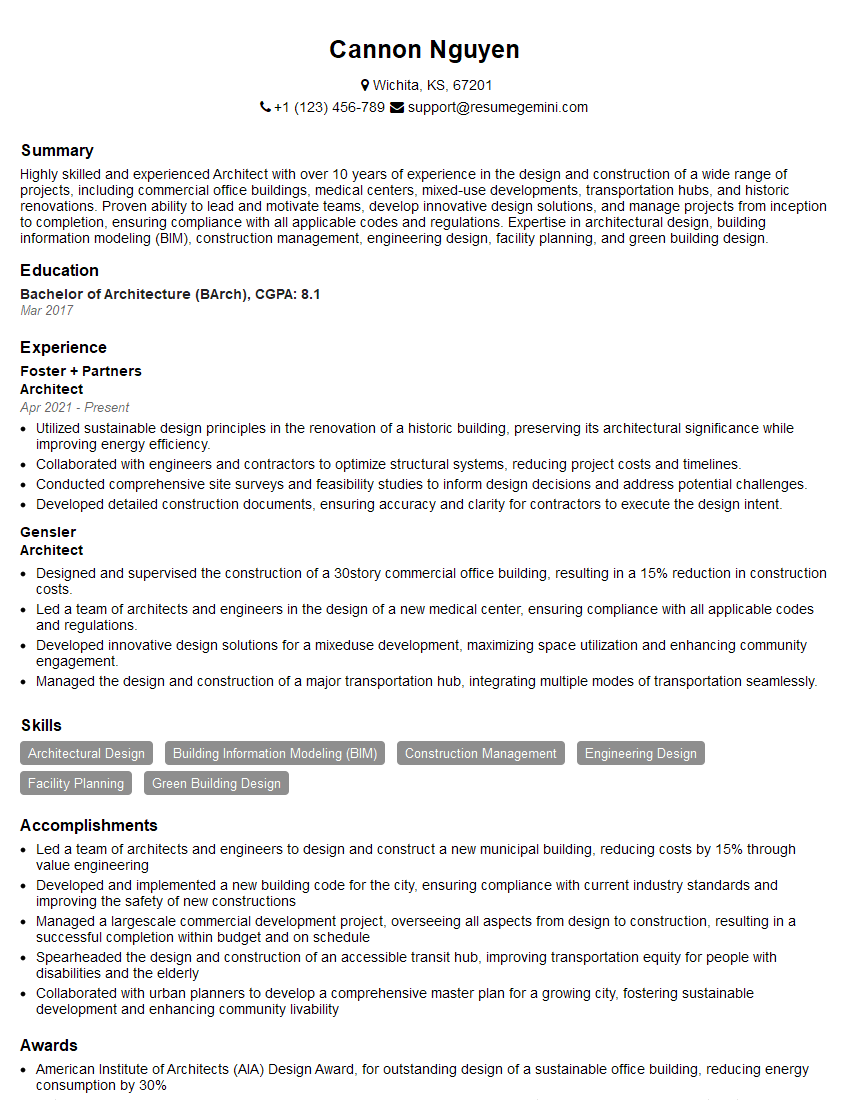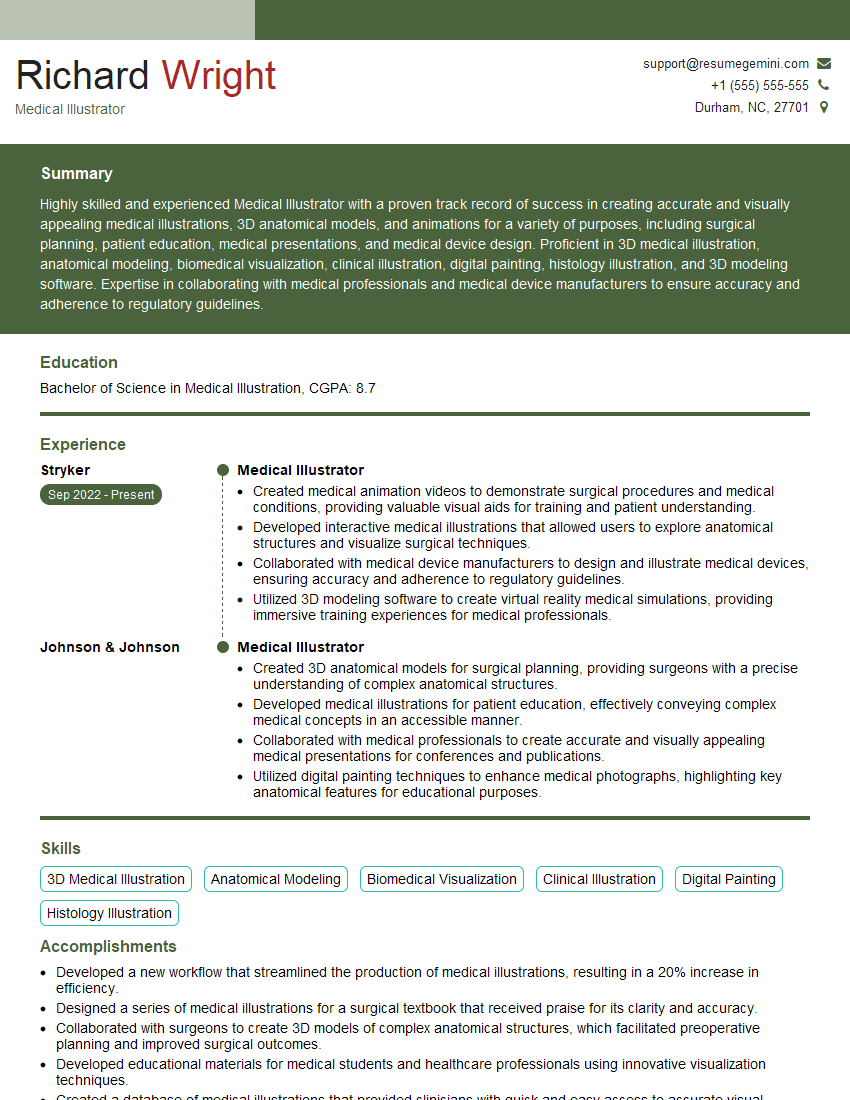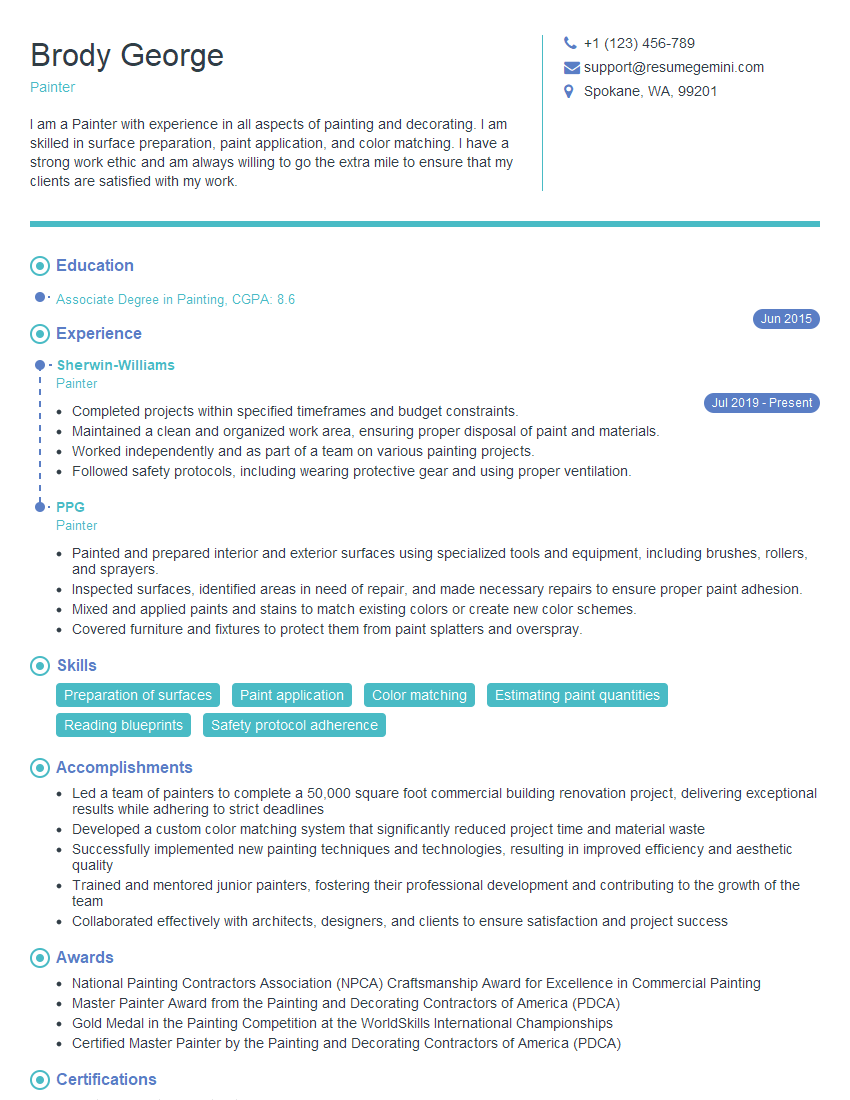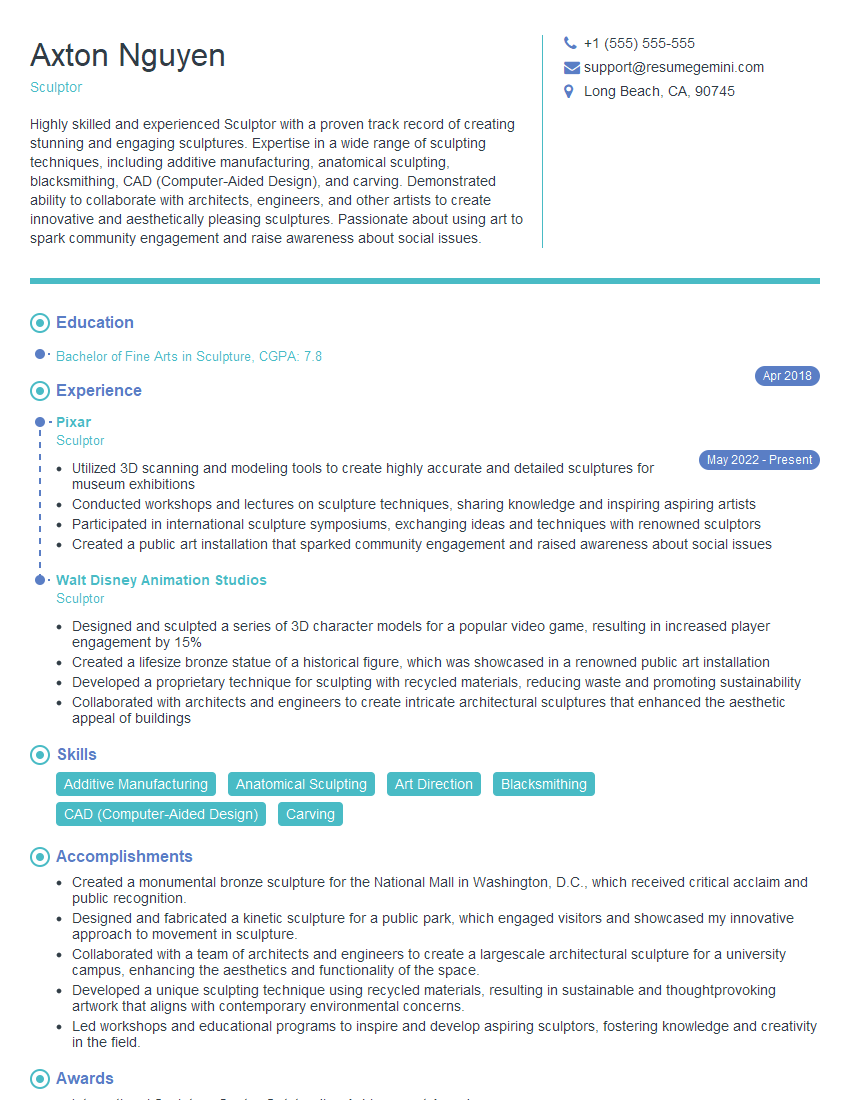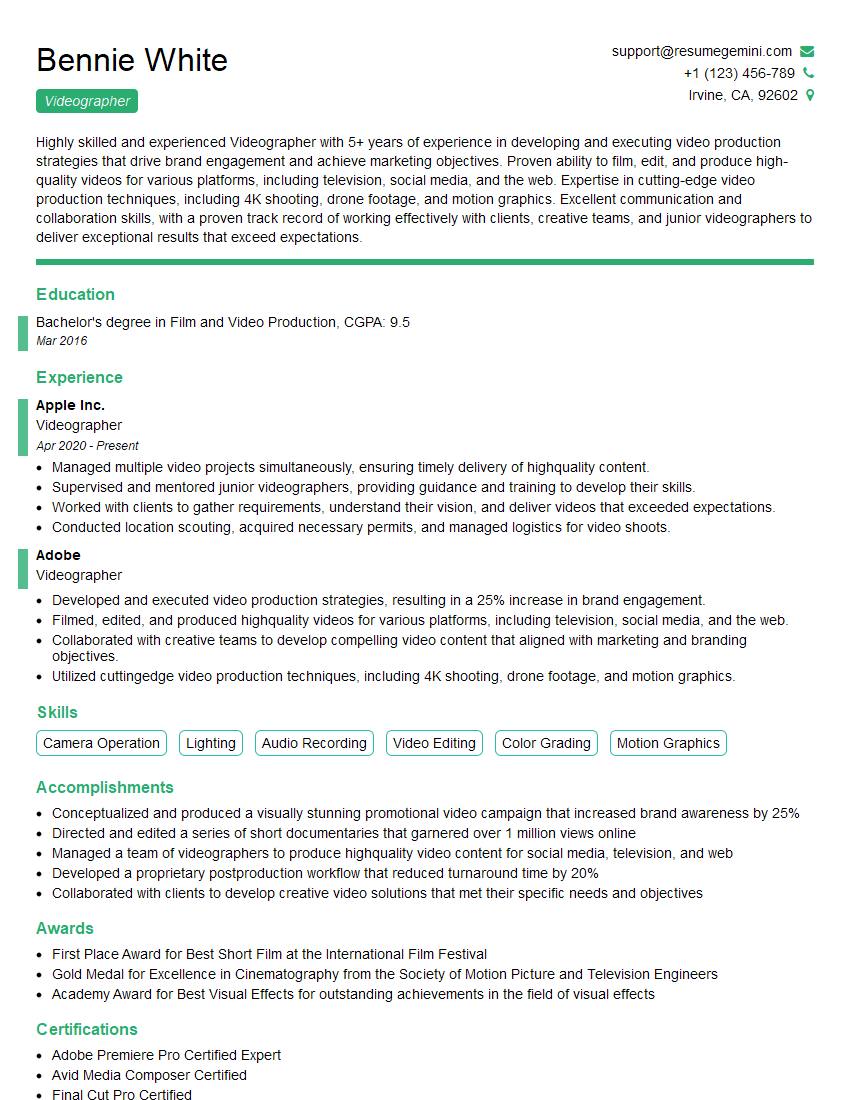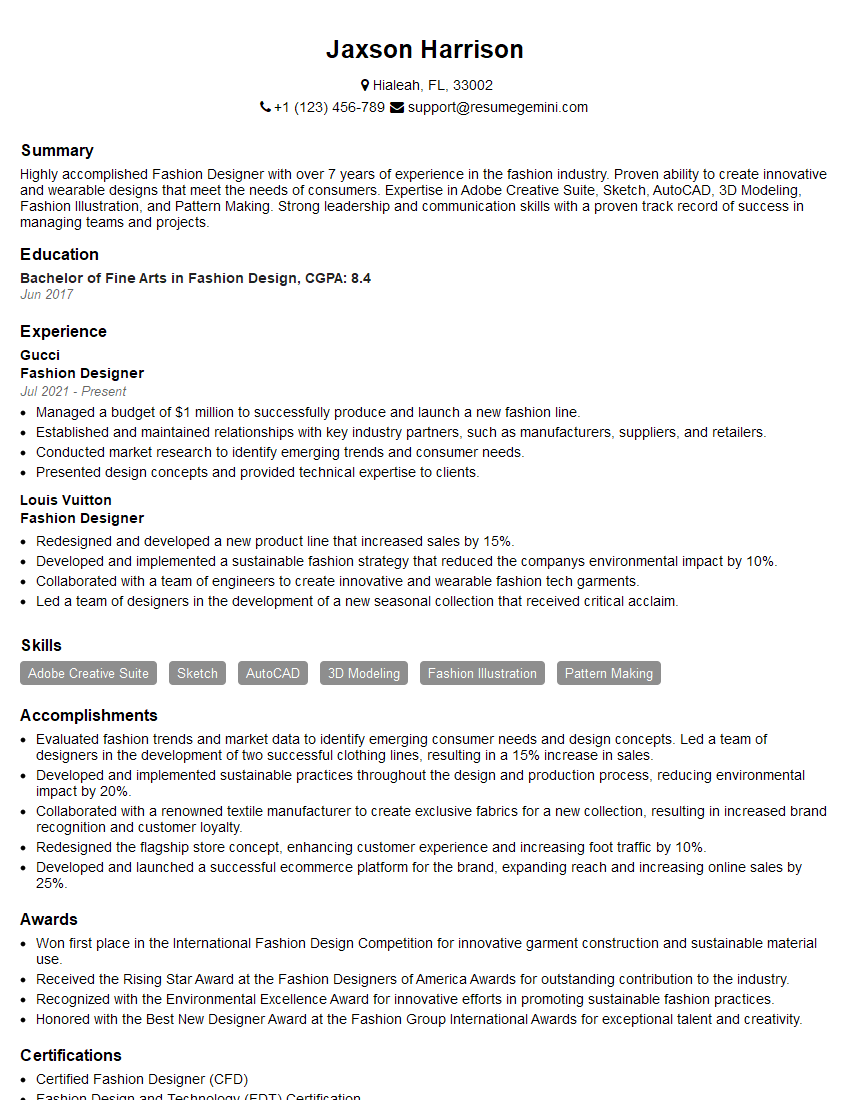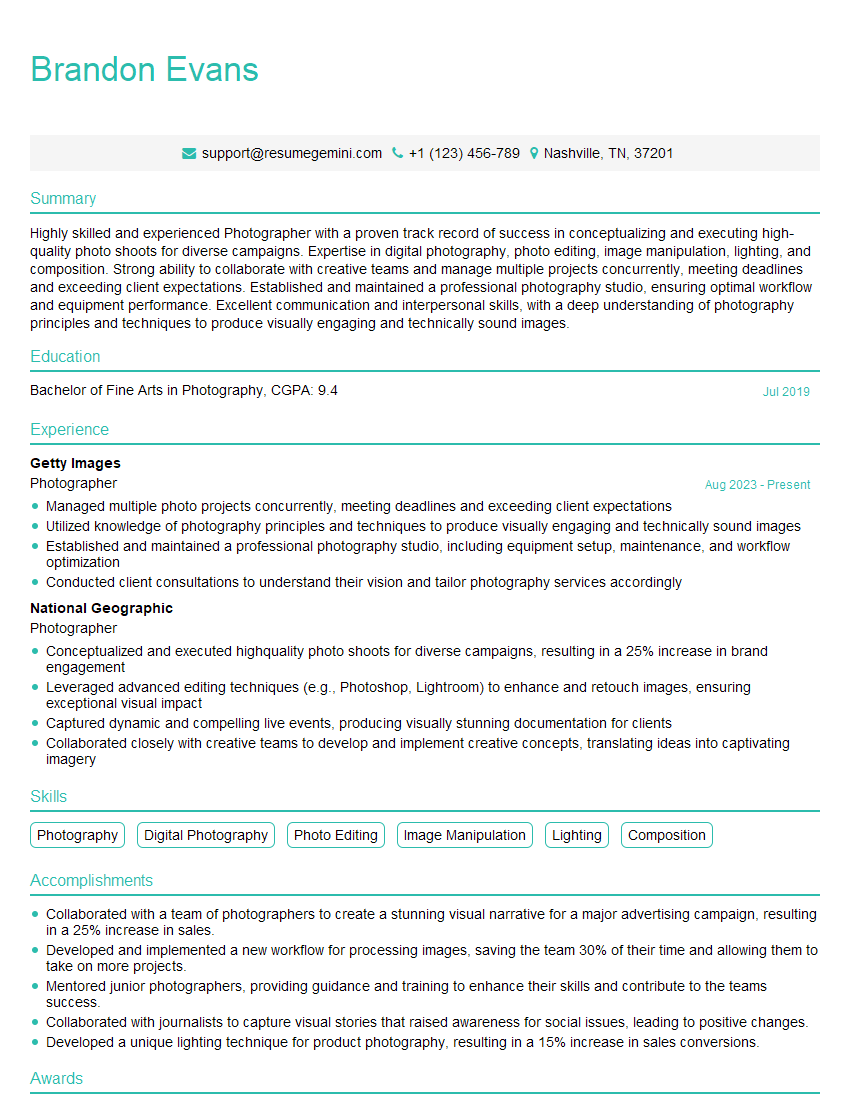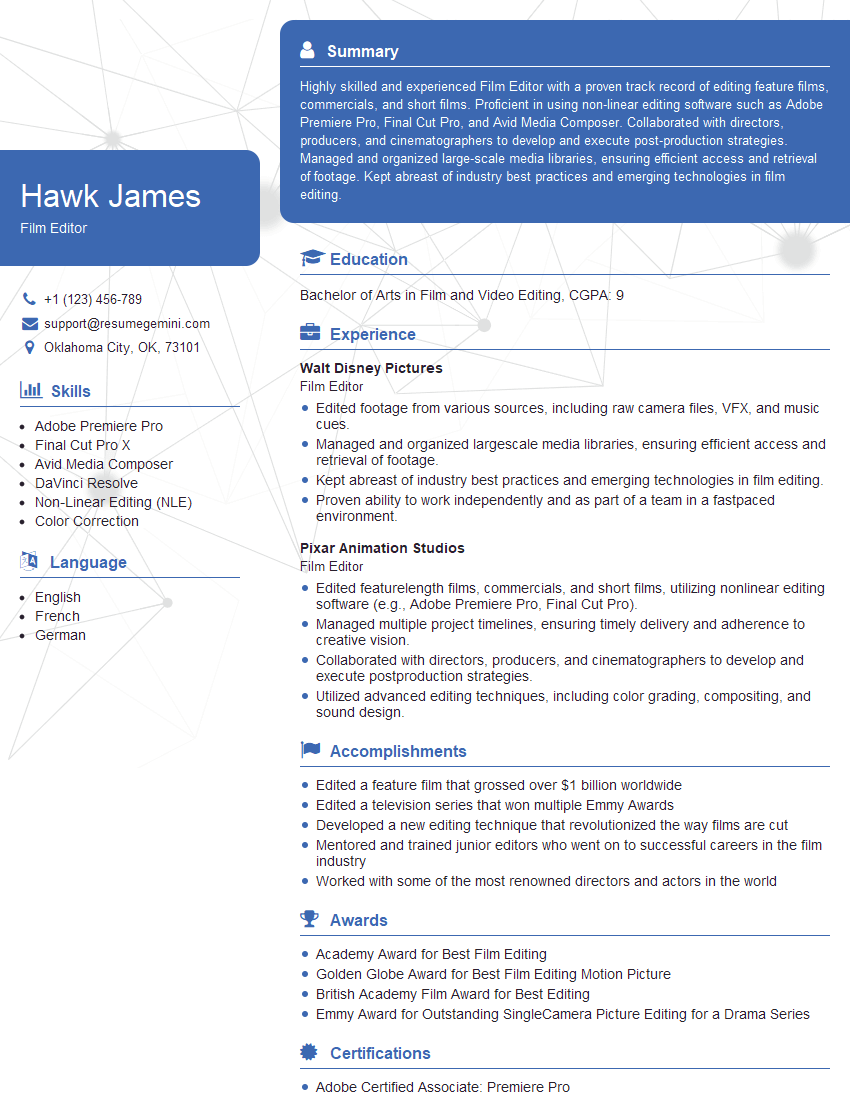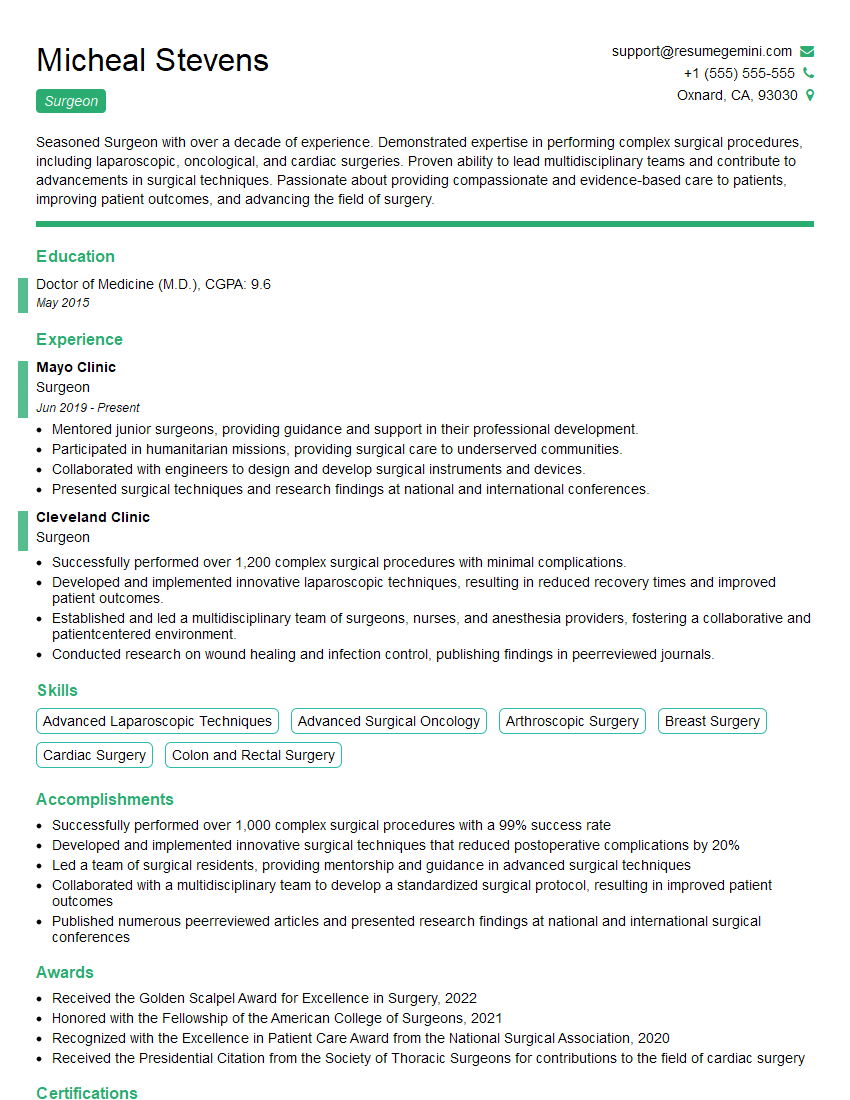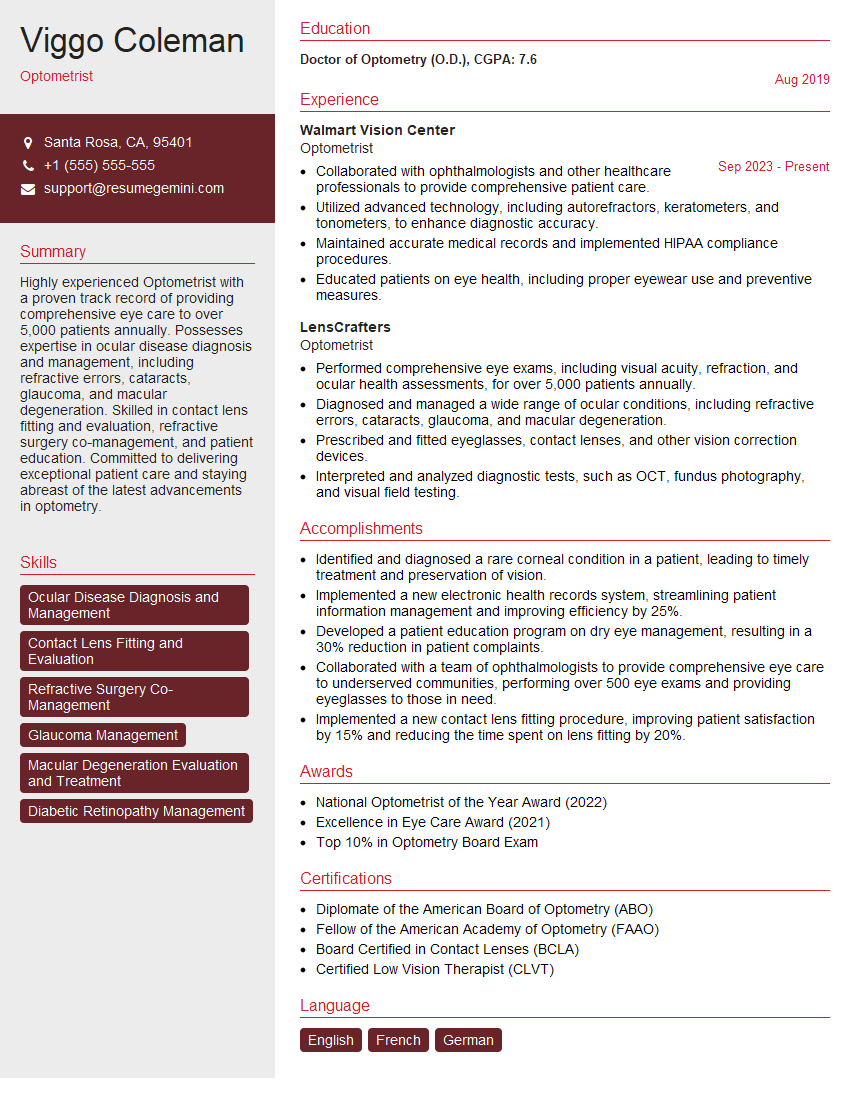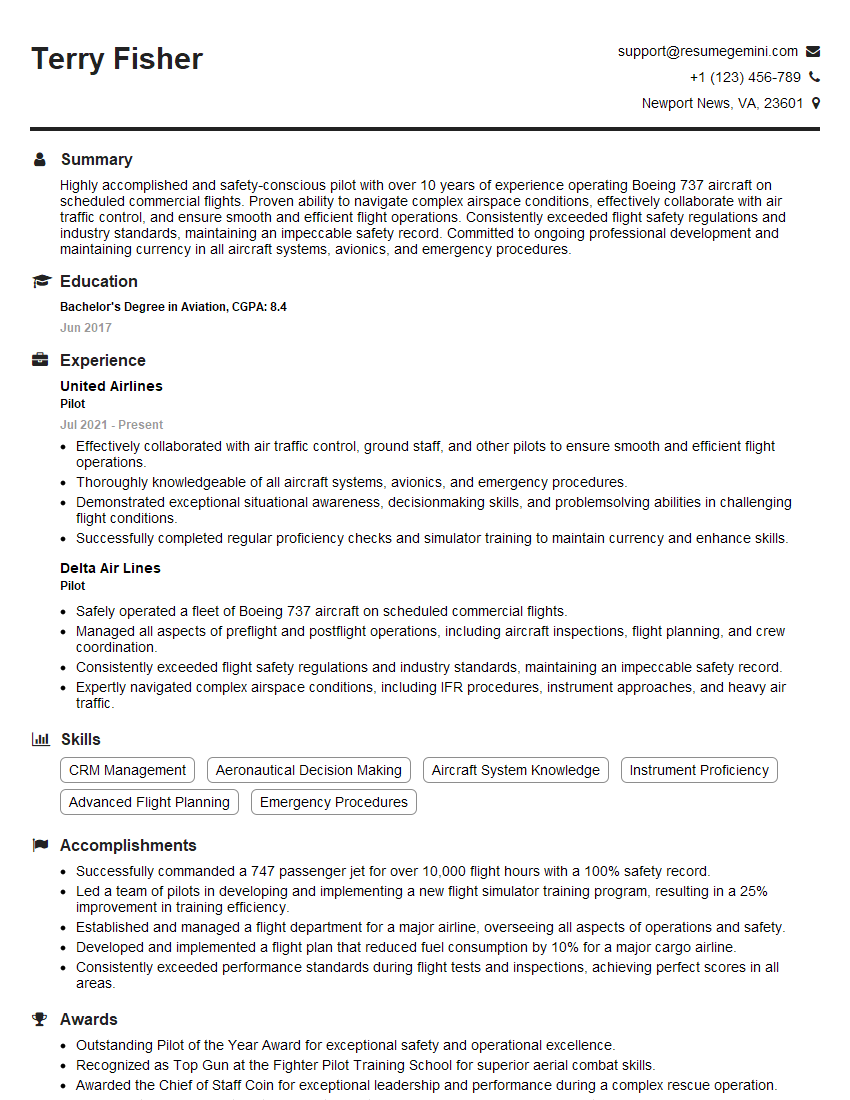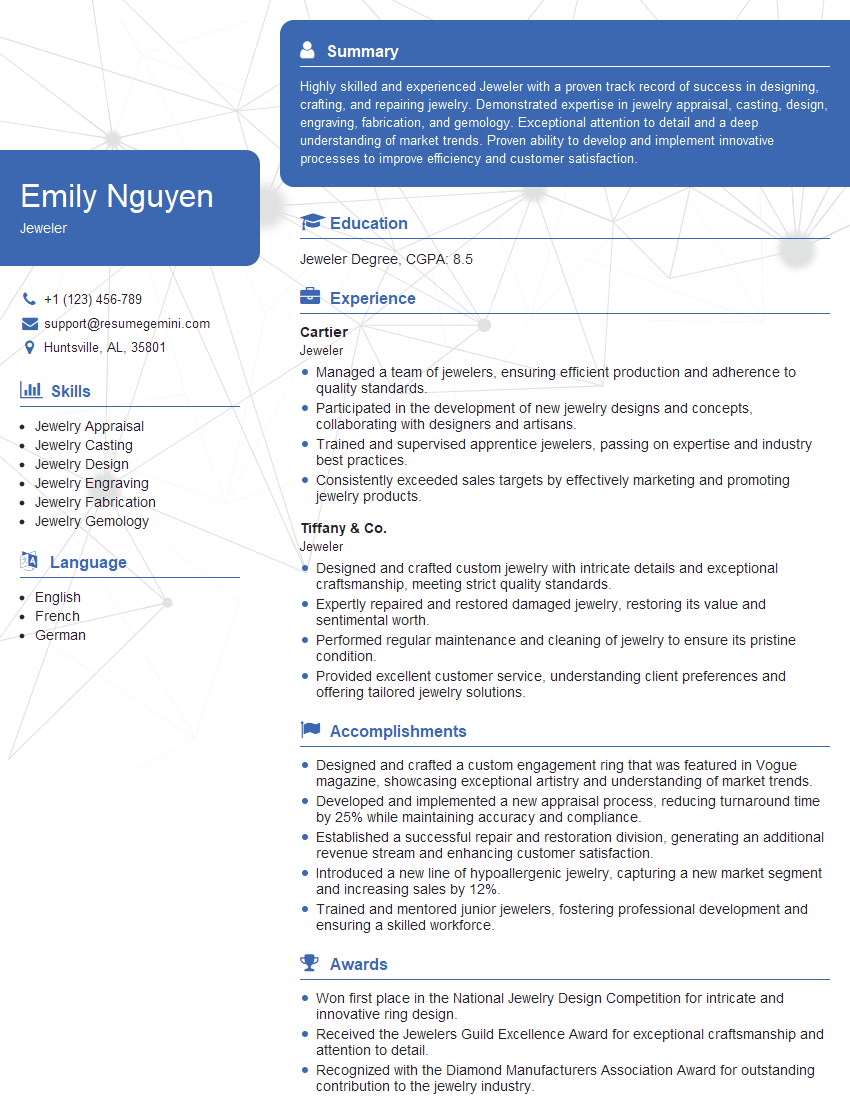Unlock your full potential by mastering the most common Excellent eyesight and color perception interview questions. This blog offers a deep dive into the critical topics, ensuring you’re not only prepared to answer but to excel. With these insights, you’ll approach your interview with clarity and confidence.
Questions Asked in Excellent eyesight and color perception Interview
Q 1. Describe your experience with tasks requiring high levels of visual acuity.
Throughout my career, I’ve consistently been involved in tasks demanding exceptional visual acuity. This includes tasks ranging from microscopic examinations of intricate samples to detailed image analysis requiring the discernment of minute differences. For instance, during my time at a textile company, I was responsible for inspecting high-quality fabrics for flaws. My ability to detect even the smallest imperfections, such as inconsistencies in weave or minor discolorations, was crucial in maintaining the company’s reputation for excellence. Another example involves my work in quality control for printed circuit boards; identifying minuscule soldering defects or trace inconsistencies was paramount to ensuring product functionality and reliability. These experiences have honed my visual acuity and attention to detail to an exceptional level.
Q 2. How would you assess the color accuracy of a printed piece?
Assessing the color accuracy of a printed piece involves a multi-step process. First, I would verify the color profile used during printing – this ensures the correct color space (e.g., CMYK) was employed. Next, I would use a calibrated spectrophotometer to measure the actual colors on the printed piece and compare them against the target values from the original digital file or a color standard. This device objectively measures the spectral reflectance of the printed inks, providing accurate numerical data. I’d then analyze the Delta E (ΔE) values, a metric indicating the difference between the target and actual colors. A lower ΔE value indicates better color accuracy. I also perform a visual inspection under standardized lighting conditions to account for any subtle differences not captured numerically. This often involves comparing the printed piece against a color chart or reference material under controlled light. Finally, I would document all findings, including spectrophotometer data and visual observations, to create a comprehensive assessment report.
Q 3. Explain your understanding of color spaces (e.g., RGB, CMYK).
Color spaces are essentially different ways of representing colors numerically. RGB (Red, Green, Blue) is an additive color model used in digital displays like monitors and screens. Each color is represented by the intensity of red, green, and blue light. Think of your computer screen – the pixels are combinations of these three colors. CMYK (Cyan, Magenta, Yellow, Key/Black) is a subtractive color model used in printing. Here, colors are created by subtracting colors from white light. The process is analogous to mixing paints – adding more cyan, magenta, yellow or black will result in darker colors. The ‘K’ represents black, which is often added to improve sharpness and reduce ink usage. The key difference lies in how colors are created: additive (light) vs. subtractive (pigment). Understanding these differences is crucial for accurate color reproduction across different media. For instance, a color that looks vibrant on an RGB screen might appear duller when printed using CMYK, necessitating color profile adjustments during the printing process.
Q 4. How do you detect subtle color variations?
Detecting subtle color variations involves a combination of trained observation and tools. Firstly, I rely on my keen color perception, which allows me to discern minor shifts in hue, saturation, or brightness. This is often enhanced by working under controlled lighting conditions to eliminate variations caused by ambient light. Secondly, I employ specialized tools like calibrated monitors and spectrophotometers to provide objective measurements. I often use side-by-side comparisons, placing the slightly different colors next to each other under standardized light to highlight even minuscule differences. Training my eyes to be sensitive to these small changes is essential; it’s a process that requires consistent practice and a keen understanding of color theory. For example, I might use a color checker chart to identify deviations in a specific color across different print runs.
Q 5. Describe a situation where your excellent eyesight was critical to solving a problem.
During a project involving the restoration of antique maps, I discovered a previously unnoticed detail thanks to my excellent eyesight. The map, heavily faded and damaged, revealed a tiny, almost invisible watermark upon close examination. This watermark proved to be crucial in authenticating the map and determining its age, a fact that would have been impossible to ascertain without careful visual scrutiny. The detail was so minute that it was easily overlooked even by experts in the field with standard vision. My ability to discern this detail was directly responsible for a significant breakthrough in the project, demonstrating the immense value of exceptional eyesight in fields that require detailed analysis of visual information.
Q 6. What techniques do you use to maintain your visual acuity?
Maintaining visual acuity involves a holistic approach. I prioritize regular eye exams, ensuring any potential issues are addressed promptly. I also limit prolonged periods of intense screen use, taking frequent breaks to rest my eyes. The 20-20-20 rule (every 20 minutes, look at something 20 feet away for 20 seconds) is particularly useful. A balanced diet rich in antioxidants, including fruits and vegetables, plays a significant role. I incorporate regular exercise to improve overall health and blood circulation, further contributing to eye health. Finally, I avoid rubbing my eyes and use appropriate eye protection when engaging in activities that might pose a risk to my vision.
Q 7. How familiar are you with color vision deficiency testing?
I am very familiar with color vision deficiency testing, having worked with various methods and tools used to assess the condition. The most common tests include Ishihara plates, which utilize colored dots to form numbers that are discernible to those with normal color vision but not to individuals with certain types of color blindness. Farnsworth-Munsell 100-hue test is another method that assesses the ability to discriminate between subtle color variations. I understand that these tests are crucial for identifying and understanding the type and severity of color vision deficiencies, critical information for designing products and environments that are accessible to all.
Q 8. How would you identify and correct a color mismatch in a digital design?
Identifying and correcting color mismatches in digital design requires a keen eye and a systematic approach. First, I’d use a calibrated monitor to ensure my own perception is accurate. Then, I’d use a color management system (CMS) like Adobe Color or a similar tool. I would compare the colors in the design to the source material or provided specifications. This often involves using color pickers to obtain precise color values (e.g., RGB, HEX, CMYK). If a mismatch exists, I’d analyze the discrepancy. Is it a slight hue shift, a saturation issue, or a difference in brightness? Depending on the cause, I’d adjust the values accordingly in the design software, often iteratively checking against the target color. For instance, if a logo’s blue is too dark compared to the brand guidelines, I might increase its lightness value in the RGB model. I always keep detailed records of color adjustments to ensure consistency throughout the project.
Let’s say I’m working on a website and the primary button color is supposed to be a specific shade of green (#3CB371). If the displayed green is noticeably different, I use my CMS to determine the exact RGB/HEX value of the displayed color and then compare it to #3CB371. This would then guide the necessary adjustments to match the specifications.
Q 9. Explain your experience with using color-matching software.
I have extensive experience with various color-matching software, including Adobe Color, Pantone Connect, and Datacolor Spyder software for monitor calibration. Adobe Color allows for precise color picking and conversion across various color models, helping maintain consistency between digital and print. Pantone Connect is invaluable for working with established Pantone color standards. My workflow typically involves using these tools to define a central color palette, ensuring that colors remain consistent across multiple design elements. The Spyder software is crucial for accurate monitor calibration, which is a foundational step in ensuring the reliability of any color work.
For example, in a recent project involving a branding refresh, I used Adobe Color to create a color palette based on the client’s preferred shades. Then, using Pantone Connect, I cross-referenced those colors with Pantone’s library to find the closest matching Pantone numbers, facilitating seamless transition to print materials.
Q 10. Describe your approach to evaluating the quality of images or visuals.
Evaluating image and visual quality involves considering several factors. Sharpness is key; a blurry image lacks detail and professionalism. Resolution is crucial, especially for print materials – low resolution will lead to pixelation. Color accuracy is paramount; accurate colors are essential for conveying brand identity or setting the correct mood. Contrast and dynamic range also matter; poor contrast makes an image muddy and hard to see, while a limited dynamic range results in loss of detail in highlights and shadows. Finally, I look for artifacts, such as banding or noise, which detract from the overall quality. I often use specialized software (like Photoshop) to zoom in and examine images closely, to assess these elements more precisely.
For example, if I’m reviewing photos for a marketing campaign, I’ll check the sharpness using a zoom tool to ensure there is no noticeable blurriness. If the photos were taken in low-light conditions, I will also analyze the noise level, looking for any grain or artifacts that might be distracting.
Q 11. How do you ensure consistent color across different devices and media?
Maintaining color consistency across devices and media requires a multi-faceted approach. Firstly, using a standardized color space like sRGB or Adobe RGB is crucial. These spaces are designed for web and print, respectively, and offer broader gamut coverage than others. Next, accurate monitor calibration is essential to ensure what I see on my screen closely matches the final output. Profiling my printer and using color management in my design software (like Adobe Photoshop or InDesign) help further bridge the gap between screen and print. Finally, I always provide clients with color specifications (like Pantone codes for print) to eliminate ambiguity and ensure the print process matches the digital design.
Imagine designing a marketing brochure. Consistent color is critical for brand recognition. By using Pantone codes, and by using a calibrated workflow, I ensure the final print matches the on-screen preview, avoiding costly reprints.
Q 12. How would you address a situation where you suspected a colleague’s color vision was impacting their work?
Addressing a colleague’s potential color vision deficiency requires tact and sensitivity. I would first observe their work carefully and subtly look for patterns of color mismatches or inconsistencies. Then, I’d have a private conversation. I wouldn’t accuse them of having a problem, but rather express my concern about some discrepancies I’ve noticed in their color choices. I would offer the opportunity to collaborate on a project, where we could compare our color perceptions and I could gently suggest solutions. If they’re open to it, I might casually suggest they consider a color vision test. Ultimately, I would focus on finding collaborative solutions that allow them to contribute effectively, even if their color perception differs from mine.
For example, providing them with color reference charts or using color-blind-friendly color palettes would be helpful strategies to compensate for potential challenges.
Q 13. What are the limitations of human color perception?
Human color perception has limitations. One major limitation is individual variation; not everyone perceives colors identically. Color blindness affects a significant portion of the population, altering how they see certain colors. Another limitation is the impact of surrounding colors; a color might appear different based on its context. Furthermore, the lighting conditions in which a color is viewed significantly affect its appearance. Our perception also has a limited dynamic range; we struggle to differentiate subtle gradations in very light or very dark areas. Finally, human perception is subjective; there’s inherent ambiguity in describing or matching colors accurately without relying on objective color standards.
For example, two people might perceive a slightly different shade of blue in the same image, leading to discrepancies in design choices if there isn’t a clear standard or reference.
Q 14. How would you calibrate a monitor for accurate color representation?
Calibrating a monitor involves using a colorimeter or spectrophotometer, specialized devices that measure the actual colors displayed on the screen, comparing them to a standard. Software accompanying these devices guides you through the calibration process. The process typically involves adjusting the monitor’s brightness, contrast, gamma, and white point settings to achieve an accurate representation of colors. Regular calibration (monthly, at least) is crucial to maintain accuracy as monitors drift over time. After calibration, I’d confirm the accuracy by viewing test images with known color values to verify the results. Accurate calibration is essential for reliable color work in design and image editing.
I usually use Datacolor Spyder software with a connected colorimeter. The software guides me through the steps, and afterwards I check the calibration with a test image to ensure its accuracy.
Q 15. Explain your experience with different types of visual inspection equipment.
My experience with visual inspection equipment is extensive, encompassing a wide range of technologies. I’ve worked with everything from basic magnifying glasses and microscopes to advanced digital imaging systems and spectral analyzers. For example, I’ve utilized stereo microscopes for intricate circuit board inspections, identifying minute solder flaws invisible to the naked eye. With digital microscopes, I’ve captured high-resolution images for detailed analysis and documentation, crucial in quality control. Spectral analyzers have allowed me to accurately assess the color composition of materials, ensuring consistency and detecting subtle deviations from specifications. My proficiency extends to specialized cameras equipped with macro lenses and adjustable lighting, essential for capturing high-quality images in various contexts.
- Stereo Microscopes: Provide three-dimensional views ideal for inspecting intricate surfaces.
- Digital Microscopes: Offer high-resolution imaging and digital documentation capabilities.
- Spectral Analyzers: Measure the precise wavelengths of light reflected or emitted by a material, allowing for accurate color analysis.
- Macro Lenses and Adjustable Lighting: Essential for capturing detailed images of small objects.
Career Expert Tips:
- Ace those interviews! Prepare effectively by reviewing the Top 50 Most Common Interview Questions on ResumeGemini.
- Navigate your job search with confidence! Explore a wide range of Career Tips on ResumeGemini. Learn about common challenges and recommendations to overcome them.
- Craft the perfect resume! Master the Art of Resume Writing with ResumeGemini’s guide. Showcase your unique qualifications and achievements effectively.
- Don’t miss out on holiday savings! Build your dream resume with ResumeGemini’s ATS optimized templates.
Q 16. How do you maintain focus and accuracy during prolonged periods of visual work?
Maintaining focus and accuracy during prolonged visual work requires a multi-pronged approach. Firstly, I prioritize regular breaks. The 20-20-20 rule – looking at an object 20 feet away for 20 seconds every 20 minutes – is a simple yet effective technique. Beyond breaks, I ensure proper posture and lighting to minimize eye strain. Adequate lighting, preferably natural light supplemented by adjustable task lighting, is critical. I also employ techniques like focusing on a specific detail within the inspection area to maintain concentration, then slowly scanning across the whole image systematically. Finally, I ensure my workspace is organized and free from distractions, creating a conducive environment for concentrated work. Think of it like a marathon runner pacing themselves; short bursts of focus interspersed with recovery periods are crucial for long-term performance.
Q 17. Describe your understanding of color theory and its practical applications.
My understanding of color theory is grounded in its fundamental principles: hue, saturation, and value (or brightness). Hue refers to the pure color, like red, blue, or green. Saturation describes the intensity or purity of a color; a highly saturated color is vivid, while a desaturated one is muted. Value represents the lightness or darkness of a color. Understanding these elements allows me to accurately assess color differences and inconsistencies. For example, I can distinguish between two shades of blue that appear very similar to the untrained eye, identifying subtle variations in saturation or value. This knowledge is crucial in many practical applications, including quality control, product design, and image editing, ensuring that colors are consistent and meet specific requirements across various media and manufacturing processes. It’s like being a painter who understands how to mix colors precisely to achieve a specific effect.
Q 18. How familiar are you with different color models (e.g., Pantone, RAL)?
I’m highly familiar with various color models, including Pantone and RAL. Pantone Matching System (PMS) is widely used in graphic design, printing, and fashion for consistent color reproduction across different mediums. Each Pantone color is assigned a unique number, facilitating accurate communication and replication. RAL (Reichs-Ausschuß für Lieferbedingungen) is another widely recognized color system, predominantly used in the paint and coatings industry. Understanding both systems is essential in various tasks; for instance, if a client provides a Pantone color code, I can immediately identify the precise shade and its corresponding values, ensuring color accuracy in manufacturing, printing, or quality inspection. This knowledge helps bridge the communication gap between designers, manufacturers, and clients.
Q 19. How would you handle a situation where you experienced temporary eye strain?
If I experience temporary eye strain, I immediately implement a few strategies. First, I take a break from the visual task and follow the 20-20-20 rule. I also apply warm compresses to my eyes to relax the eye muscles. If the strain persists, I adjust my lighting and workspace to ensure optimal conditions. Hydration is key, so I drink plenty of water. I might also briefly use artificial tears to lubricate my eyes. If the strain continues or worsens, I consult an ophthalmologist to rule out any underlying issues. Early intervention is critical to prevent more serious problems.
Q 20. Explain the importance of lighting in accurate color perception.
Lighting plays a paramount role in accurate color perception. Different light sources emit varying wavelengths, affecting how colors appear. Incandescent lighting, for instance, tends to cast a warmer, yellowish light, while fluorescent lighting can appear cooler and bluer. Natural daylight varies throughout the day, influencing color perception. For accurate color assessment, standardized lighting conditions are crucial. Many industries use light boxes with controlled spectral output, ensuring consistent illumination for color matching and quality control. This minimizes discrepancies caused by variations in ambient light. Imagine trying to match paint colors under different lighting conditions; the results would be inconsistent and unreliable. Standardized lighting eliminates this variability.
Q 21. Describe your experience with using specialized tools or software to enhance visual perception.
My experience with tools and software to enhance visual perception is extensive. I’ve used color calibration software to ensure the accuracy of monitors and display devices used for color-critical tasks. Image processing software enables adjustments like contrast enhancement, noise reduction, and color correction, leading to improved clarity and detail in images. Specialized software for microscopic image analysis allows for precise measurements and the identification of subtle features, otherwise invisible to the naked eye. For example, in inspecting microchips, image enhancement software can reveal hairline cracks or imperfections that are crucial to identifying defects. These tools enable detailed analysis and documentation, increasing accuracy and efficiency. These tools are extensions of my visual capabilities, enabling me to tackle complex tasks with greater precision.
Q 22. How do you ensure consistent color reproduction in print materials?
Ensuring consistent color reproduction in print is crucial for achieving the intended visual impact. It involves a multi-step process that begins long before the printing press. We start by using a color management system (CMS), which ensures that the colors we see on our screens accurately represent the colors that will appear on the printed piece. This involves careful selection of color profiles (e.g., sRGB, Adobe RGB, etc.), which define the relationship between digital color values and the actual colors produced by a specific device (monitor, printer).
For example, if we are designing a brochure with vibrant blues, we wouldn’t use a profile that has a limited range in blues. We also need to consider the type of paper – different papers absorb inks differently, impacting the final color. Coated papers typically yield more vibrant results compared to uncoated ones. To ensure accuracy, we create color proofs, which are test prints that show the final colors, and we then compare them against the digital file to identify and address any discrepancies. Finally, proper calibration of printing equipment is essential; regular maintenance and calibration ensure consistent ink distribution and color output.
Q 23. What are some common causes of color distortion in images?
Color distortion in images can stem from various sources. One common culprit is incorrect color profiles, as mentioned earlier. If the image is viewed on a screen with a different profile than the one it was created with, you’ll see noticeable differences. Lighting conditions also play a significant role; images taken under incandescent lighting will have a warmer cast compared to those taken under fluorescent or daylight conditions.
Another source is image compression; JPEG compression, for example, can lead to color banding (gradual shifts in color instead of smooth transitions) and information loss. Improper white balance settings in cameras or scanners can result in an overall color cast (e.g., image too blue or too yellow). Lastly, issues with the display device itself—such as an improperly calibrated monitor—can lead to color distortion. Think of it like trying to paint a masterpiece with paints that are consistently the wrong shade.
Q 24. How would you troubleshoot a problem related to inaccurate color reproduction?
Troubleshooting inaccurate color reproduction involves a systematic approach. First, I’d examine the image file’s color profile to ensure it’s compatible with the output device. Next, I would verify the color settings of the monitor or other display devices used for review. Inconsistent color profiles between the creative software, the output device, and the display can lead to major discrepancies.
Then, I would check the calibration of the printer or the monitor. A poorly calibrated device will produce inaccurate colors regardless of the color profile. If the problem persists, I’d create a test print using a color management system to isolate potential problems with color profiles or device settings. By carefully comparing the test print to the original digital file and systematically eliminating possibilities, I can pinpoint the cause of the color inaccuracy. I can also compare the image to a properly printed control image to check for inconsistencies.
Q 25. What strategies do you use to minimize eye fatigue during intensive visual work?
Minimizing eye fatigue during intense visual work is paramount for maintaining both productivity and ocular health. My strategies focus on optimizing my work environment and incorporating regular breaks. I use a monitor with low blue light emission, and I ensure the screen’s brightness is appropriately adjusted to match the ambient lighting. The 20-20-20 rule (every 20 minutes, look at something 20 feet away for 20 seconds) is a habit I diligently follow.
Furthermore, I ensure my workstation is ergonomically designed – maintaining proper posture and keeping the screen at eye level reduces strain. Regular breaks involve looking away from the screen, getting up to move around, or performing simple eye exercises (such as focusing on distant objects and then close objects). I also use anti-glare screen protectors to minimize reflection and eye strain. Proper lighting is essential; avoiding harsh overhead lighting and using task lighting that reduces shadows and glare helps significantly.
Q 26. How would you describe your ability to differentiate between subtle shades and hues?
My ability to differentiate between subtle shades and hues is exceptionally refined. I can readily distinguish minute variations in color saturation and hue, often noting nuances imperceptible to others. This is a skill honed through years of experience and attention to detail. For example, I can easily distinguish between two blues that differ by only a few points in their RGB values, a task which most people would find impossible without specialized tools.
This precision allows me to achieve the finest details in color grading, color correction, and precise color matching. I can tell the difference between a color and its neighboring color in a hue, saturation, and lightness space. For example, I could differentiate between the color of two different shades of red, with minute distinctions in their undertones. This is vital in situations requiring the most accurate color representation, like in publishing, graphic design, or photography.
Q 27. Describe your experience working under various lighting conditions.
I have extensive experience working under diverse lighting conditions, both natural and artificial. My proficiency in color perception allows me to adapt and accurately assess colors across different light sources. Whether it’s the warm glow of incandescent lighting, the cooler tones of fluorescent lights, or the changing spectrum of daylight throughout the day, I can consistently judge colors accurately.
This adaptability is vital, particularly in scenarios requiring on-site assessments or when dealing with color-critical tasks in diverse settings. For example, during a print job, I can assess the colors of the printed materials and match them to the digital mockups consistently even under different environmental lighting. It’s akin to a musician being able to play their instrument with precision regardless of the acoustics of the room.
Q 28. How would you assess the quality of visual information presented in various formats (e.g., print, digital, video)?
Assessing the quality of visual information across various formats requires a multifaceted approach. For print materials, I examine factors like color accuracy, sharpness, resolution, and the overall fidelity of the reproduced image to the original. I would assess the paper quality, the ink consistency, and the presence of any defects. For digital formats, I assess the image resolution, the color gamut, the compression artifacts, and the overall clarity and vibrancy of the colors.
With video, my assessment extends to aspects like color grading, dynamic range, motion clarity, and the absence of artifacts such as banding or compression artifacts. In each case, the assessment is based on understanding the intended use of the visual information and considering the technical limitations of the respective format. I essentially perform a quality control evaluation based on the context of use and the technical specifications of the presentation format.
Key Topics to Learn for Excellent Eyesight and Color Perception Interview
- Visual Acuity and its Measurement: Understand the different methods used to assess visual acuity (e.g., Snellen chart) and the implications of various levels of acuity in different professions.
- Color Vision Deficiency (CVD) and its impact: Learn about different types of color blindness (protanopia, deuteranopia, tritanopia) and how they affect tasks requiring precise color differentiation. Explore technologies and strategies used to mitigate the impact of CVD.
- Depth Perception and Stereoscopic Vision: Explore the principles of depth perception and its importance in tasks involving spatial awareness and precision. Discuss the implications of impaired depth perception in various professional contexts.
- Practical Applications: Consider the role of excellent eyesight and color perception in fields such as design (graphic, web, industrial), medical imaging, quality control, aviation, and driving. Prepare examples showcasing how your skills translate to these fields.
- Technological Aids and Compensatory Strategies: Familiarize yourself with assistive technologies (e.g., color correction software, specialized eyewear) and strategies that individuals with visual impairments may utilize to perform tasks requiring excellent eyesight and color perception.
- Problem-Solving Approaches: Practice describing situations where you have had to overcome challenges related to visual tasks, emphasizing your problem-solving skills and adaptability.
Next Steps
Mastering the concepts of excellent eyesight and color perception is crucial for career advancement in numerous fields demanding visual precision and accuracy. A strong understanding of these principles, coupled with a well-crafted resume, significantly increases your chances of securing your desired role. To maximize your job prospects, create an ATS-friendly resume that highlights your skills and experience effectively. ResumeGemini is a trusted resource that can help you build a professional and impactful resume. We provide examples of resumes tailored to candidates with excellent eyesight and color perception to guide you in crafting your own compelling application materials.
Explore more articles
Users Rating of Our Blogs
Share Your Experience
We value your feedback! Please rate our content and share your thoughts (optional).
What Readers Say About Our Blog
Hello,
We found issues with your domain’s email setup that may be sending your messages to spam or blocking them completely. InboxShield Mini shows you how to fix it in minutes — no tech skills required.
Scan your domain now for details: https://inboxshield-mini.com/
— Adam @ InboxShield Mini
Reply STOP to unsubscribe
Hi, are you owner of interviewgemini.com? What if I told you I could help you find extra time in your schedule, reconnect with leads you didn’t even realize you missed, and bring in more “I want to work with you” conversations, without increasing your ad spend or hiring a full-time employee?
All with a flexible, budget-friendly service that could easily pay for itself. Sounds good?
Would it be nice to jump on a quick 10-minute call so I can show you exactly how we make this work?
Best,
Hapei
Marketing Director
Hey, I know you’re the owner of interviewgemini.com. I’ll be quick.
Fundraising for your business is tough and time-consuming. We make it easier by guaranteeing two private investor meetings each month, for six months. No demos, no pitch events – just direct introductions to active investors matched to your startup.
If youR17;re raising, this could help you build real momentum. Want me to send more info?
Hi, I represent an SEO company that specialises in getting you AI citations and higher rankings on Google. I’d like to offer you a 100% free SEO audit for your website. Would you be interested?
Hi, I represent an SEO company that specialises in getting you AI citations and higher rankings on Google. I’d like to offer you a 100% free SEO audit for your website. Would you be interested?
good


